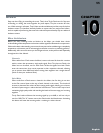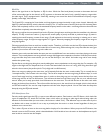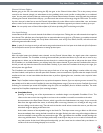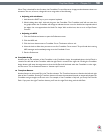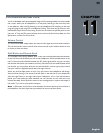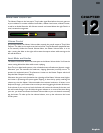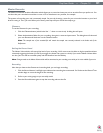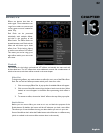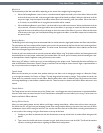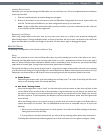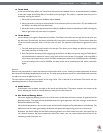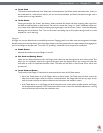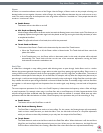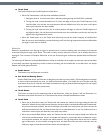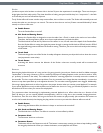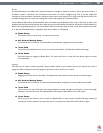
Torq User Guide » Chapter 1
63
Torq User Guide » Chapter 13
63
Mix Knob
The functionality of the Mix knob differs depending on the status of the neighboring Routing button:
» When the Routing Button is set to Insert—the Mix knob will adjust the wet/dry mix of the effect. When the Mix
knob is all the way to the left, only the original audio signal will be heard (no effect). When the Mix knob is all the
way to the right, only the output of the effect will be heard, thus becoming a full insert effect. When the knob is
at 12 o’clock, an even 50/50 mix of dry signal and wet effect will be created.
» When the Routing Button is set to Send—the knob will act as an effect send amount. When the Mix knob is all the
way to the left, no amount of the signal will be sent to the effect. As you begin to rotate the Mix knob clockwise,
signal will be sent to the effect and you will begin to hear the results of the effect in your mix. When the Mix knob
is all the way to the right, you’ll actually be boosting the signal to the effect, so the effect output can be louder than
the source audio.
Routing Button
The Routing button will change how the associated effect is routed within the signal path between the Deck and the Mixer.
The two options are Insert mode and Send mode. Insert mode is characterized by the fact that the entire audio signal from
the Deck is replaced by the audio from the effect. The other mode, Send mode, is different in that it adds the sound of the
effect into the original signal from the Deck.
So how do you know which mode to use with a particular effect? When using Torq’s built-in effects, the Routing button will
automatically be set to the proper mode when you load the effect. Of course, part of creativity involves breaking the rules,
so do experiment with the opposite routing and check out the results.
When using VST effects, it will be up to you to set the Routing to the proper mode. Traditionally, Reverbs and Delays are
used as Send effects. Distortions, Phasers, Flangers, and Filters will normally be used as Inserts. Again, experimentation is
key, so try both modes to compare the results!
Tweak Knob
Effects are fun because you can alter their qualities while you use them, such as changing the length of a Reverb or Delay,
or to change the intensity of a Phaser or Flanger. To keep things simple and easy to manage, Torq provides one knob, the
Tweak knob, for parameter control on each effect. Because effects alter audio in different ways, the function of this knob
will change depending on which effect is loaded in the slot. These functions are listed in the Built-In Effect reference in this
manual.
Tweak Button
The Tweak button works in the same way as the Tweak knob—it will toggle the state of a parameter in the selected effect.
Like the Tweak knob, the exact function of the Tweak button will depend on which effect you’re using. The functions are
listed in the Built-In Effect reference.
Saving Effect Racks
When you start getting deeper into the effects, you’ll begin creating multi-effects—effect chains of more than one plug-in.
You’ll nd that you can get some jaw-dropping sounds when using multiple effects at the same time, and some of those
combinations may be worth saving for later use. You can save the entire state of an Effect Rack, including which effects are
in use as well as their settings, using the Save button at the top of the Rack:
1. Congure your Rack as desired and click the Save button at the top of the Rack. A standard Save dialog box will
appear.
2. Type a name for the le and choose a location on your hard drive to store it and click OK. The le will be saved as
a preset, containing all information regarding the Effect Rack conguration.



